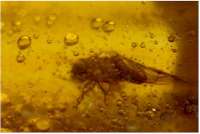Amber
by
Anita Westlake
Presented to Cotton Indian Gem and Mineral Society, March 2001; William Holland School of Lapidary Arts, June 2003;Gem Section: Georgia Mineral Society, Inc., November 2004

Insect in amber, Dominican Republic.
10 mm wide (the insect is 4 mm long).
(Julian C. Gray, specimen and photo)
British poet Alexander Pope said of amber: “Pretty! In amber to observe the forms of hairs, or straws, or dirt, or grubs, or worms! These things, we know, are neither rich nor rare, but wonder—how the devil they got there?”
What is amber? It is resin that once seeped out of the bark of trees and has fossilized. Resin protects a tree by blocking gaps in the bark. It has antiseptic properties that protect the tree from disease. Resin is a natural polymer made up of carbon, hydrogen and oxygen. It is not the same as sap, however which transports nutrients through the heartwood of a tree.
Is amber considered a mineral? No. In order to be a mineral the following five criteria have to be true:
A mineral is defined as:
1. Naturally occurring (Amber: yes)
2. Homogeneous solid (Amber: yes)
3. Definite chemical composition (Amber: yes)
4. Ordered crystalline structure (Amber: no)
5. Inorganic origin (Amber: no)
1. Naturally occurring (Amber: yes)
2. Homogeneous solid (Amber: yes)
3. Definite chemical composition (Amber: yes)
4. Ordered crystalline structure (Amber: no)
5. Inorganic origin (Amber: no)
HARDNESS:
Burmese amber is the hardest at 3.
Baltic amber is 2-2.5 (and is the most plentiful)
Dominican amber is 1-2 (2nd most plentiful) It is a geologically younger amber and tends to be softer than amber that has been buried for a long time.
FRACTURE: Conchoidal
LUSTER: Resinous
SPECIFIC GRAVITY: 1.05-1.2
FLUORESCENCE:
Some amber will fluoresce. Common fluorescent colors are blue, yellow, green, orange or white. In general, resins with higher sulfur content fluoresce more. Amber is found in 12 states in the US: NJ, NC, Alaska, MT, AK, TX, TN, NM, Maryland, MA, WA, CA and at least 13 foreign countries.
AMBER NAMES:
Fatty, Bone, Foamy (or Frothy), Soily, Scoopstone, Sea Stone or Sea Amber, Pit Amber, Ambroid (pressed amber w/uniform color and consistency). Poland has over 200 folk names for amber.
COLOR AND INCLUSIONS:
Baltic Amber: Displays various colors, most notably a warm shade of orange. 1 in every 1000 pieces contains an inclusion. Baltic amber was produced by conifers 20-50mya. 750 documented distinct plant species have been found in Baltic amber.
Dominican Amber: Usually light honey-colored. 1 in every 100 pieces contains some kind of inclusion. Primarily of Oligocene Age.
Types of inclusions: Insects, insect droppings and eggs, spiders, butterflies, moths, plants, flowers, pinecones, seeds, mushrooms (found in NJ), feathers, silk, sawdust, pyrite crystals, bubbles, water, barnacles, crabs, frogs, lizards (rarely).
COLLECTING METHODS:
Riding on horseback through marshy areas with a net and scooping up the amber was one method. Another was to lie over the side of a boat and stir the sand, causing the amber to float to the surface. Other, less informal collecting methods are dredging, mining, and hydraulic mining.
CARE OF AMBER:
DON’T:
Put your amber jewelry on before you spray your hair or use perfume.
Store with other jewelry that can chip or scratch your amber.
Use ultrasonic or steam cleaners.
Get it near cleaning solutions, lard, salad oil, butter.
DO:
String amber beads w/knots to separate each bead.
Store in a soft cloth.
Keep away from heat, open flame or direct sunlight.
Clean w/lukewarm water. Dry. Rub w/olive oil. Wipe excess off.
Put your amber jewelry on before you spray your hair or use perfume.
Store with other jewelry that can chip or scratch your amber.
Use ultrasonic or steam cleaners.
Get it near cleaning solutions, lard, salad oil, butter.
DO:
String amber beads w/knots to separate each bead.
Store in a soft cloth.
Keep away from heat, open flame or direct sunlight.
Clean w/lukewarm water. Dry. Rub w/olive oil. Wipe excess off.
USES FOR AMBER PAST AND PRESENT:
Honey mixed with powdered amber – used for asthma, gout and the black plague
Pendants worn to preserve chastity
Talismans worn to protect against evil
Burned to chase away mosquitoes and sea serpents
Cigarette holders, mouth pieces for pipes
Ship decks
Early photography
Varnish for stringed instruments (nearly all varnishes today are synthetic)
Carvings, boxes, cups and dishes, rosaries, teething rings, etc.
COPAL VS. AMBER:
Copal: a few hundred to a few million years old. It is softer than amber. Most insects in copal belong to living species. Amber: More than a “few million years old”. Amber is harder than copal and can contain extinct species of insects.
DATING AMBER:
Amber is dated based on the fossils found in the associated sediments. If the amber has eroded from one deposit and was re-deposited somewhere else, it could be much older than the sediments suggest. Another way to date amber is by insect inclusions. If a modern housefly isfound, it’s not amber, it’s plastic! (Although methods of fakery are becoming more sophisticated: forgers are now using real amber to surround their fake bugs.) Another test: true amber will powder when scraped with a knife, plastic will give off shavings.
Websites for more info:
“Deadbugsinamber” society at: http://members.tripod.com/snakefly/
“World of Amber” http://www.emporia.edu/earthsci/amber/amber.htm
“The Amber Lady” http://amberlady.com/
“Deadbugsinamber” society at: http://members.tripod.com/snakefly/
“World of Amber” http://www.emporia.edu/earthsci/amber/amber.htm
“The Amber Lady” http://amberlady.com/
FUN FACTS TO KNOW AND TELL ABOUT AMBER
- It has been poetically said of Amber that “Time has stopped inside it.”
- Soft resin can be chewed as gum with disinfecting properties. It can be used to protect scabbed sores, preventing infectious bacteria and fungi from attaching to the wound.
- The ancient Greeks found that dissolving a little resin in the wine made it keep better. (I don’t keep wine around long enough to worry about it spoiling.) This knowledge is still put to use today in the making of retsina wines, whose distinctive taste comes from the resin of the Aleppo pine.
- Succinite, the scientific term to describe authentic amber, comes from the Latin, meaning “juice stone.”
- The parallel grooves sometimes found on larger amber pieces may be the result of ice movements.
- Yellow and brown are the most common colors of amber. Red develops over time through oxidation. Oxidation also causes crazing (shallow cracks along thesurface).
- There are approximately 250 color variations of amber.
- White amber is less brittle than clear, and is therefore easier to sculpt and shape. Because of its many air bubbles, white amber can float in ordinary water: no salt needed!
- The world’s largest piece of amber weighs 150 pounds and was found on the island of Borneo.
- The surface of amber is somewhat harder than the core which indicates that the hardening process occurs from the outside-in. Generally, the harder the amber, the older it is.
- Inclusions are almost always found in transparent amber and almost never in opaque stones. One theory is that clear amber is the result of a defense mechanism whereby the tree produced and released large amounts of resin in response to a threat.
- Amber inclusions of larger animals such as fish, lizards, etc. are almost always fakes. The local lizard population in Mexico is probably endangered from the amber forgers alone!
- Be careful when doing salt solution tests: Polystyrene has the same specific gravity as amber and will float.
- Amoebas have been found trapped in amber in the actof dividing.
- Dinosaur DNA has not been extracted from the bellies of mosquitoes in amber, but in May 1995, Raul Cano revived bacterial spores from a sting-less bee entombed in amber 25-40 mya. If this feat can be substantiated, he will have been the first person to resurrect life from the past. Some say a modern strain of bacteria contaminated the experiment despite all precautions.
- Dominican amber is too young to house dinosaur DNA but NJ amber formed 30my before the dinosaurs became extinct.
- DNA is largely similar for most organisms: it contains around 90% inactive information (perhaps a reserve for future evolution?)
- Not all tree resins can form amber, as most get broken down and decay. Only 2 types of tree living today produce stable resins that could, with time, fossilize into amber.
- “Spangles” are artificially produced in real amber by heating the piece in sand.
- Pressed amber (ambroid) is commonly found in Victorian jewelry and as the stems of tobacco pipes. It is formed by fusing small pieces of amber together under high temperature and pressure.
- It was once believed by ancient people that amber was hardened lynx urine.
- In 1264 Teutonic kings tried to control the collection and sale of amber. If you were caught collecting amber w/o permission, you were hung.
- Phenolic resin (Bakelite) is the most common material to be encountered in fake amber jewelry.
- Insects in amber: If the specimen is perfectly centered in the piece, and its legs neatly stretched out and arranged, beware! Genuine spiders, for example, usually have their legs tightly curled up under their bodies in death. In Mexico, green amber does occur naturally, but it’s quite rare. Necklaces, rings, etc. are commonly made from green plastic and sold as amber. Amber can also be irradiated or heat-treated to produce the green color.
From “The Amber Book” by Ake Dahlstrom and other sources.

Copyright © Georgia Mineral Society, Inc.
